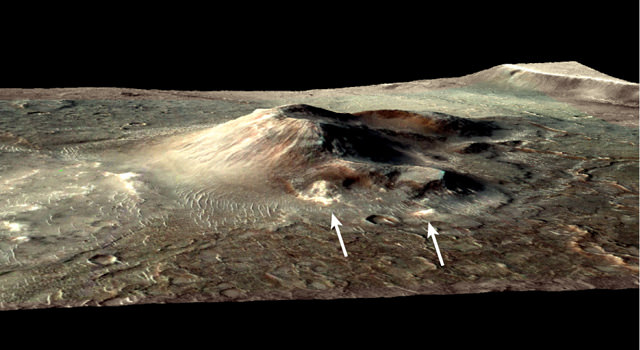[/caption]
Evidence of a past “hot spring” environment on Mars has shown up in images from the Mars Reconnaissance Orbiter. Scientists say light-colored mounds of hydrated silica on the side of a volcano are likely deposits from steam fumaroles, or hot springs, which may have provided a habitable environment on the Red Planet about three billion years ago. Concentrations of hydrated silica have been identified on Mars previously, including an ancient hot springs environment that the Spirit rover stumbled across in 2007.
“The heat and water required to create this deposit probably made this a habitable zone,” said J.R. Skok from Brown University, lead author of a paper about these findings published online today by Nature Geoscience. “If life did exist there, this would be a promising type of deposit to entomb evidence of it — a microbial mortuary.”
While it is not direct evidence of life on Mars, it adds to the mounting evidence of past habitable environments for at least microbial life on the planet, and is the most intact ancient hot springs region ever found. This specific spot in the Syrtis Major volcanic region on Mars would have been hospitable to life when most of Mars was already dry and cold.
Skok said, “You have spectacular context for this deposit. It’s right on the flank of a volcano. The setting remains essentially the same as it was when the silica was deposited.”
The small cone rises about 100 meters (100 yards) from the floor of a shallow volcanic caldera named Nili Patera and covers about 50 kilometers (30 miles) of Syrtis Major, which is near Mars equator. The collapse of an underground magma chamber from which lava had emanated created the bowl, and subsequent lave flows tell a story of how the cone formed.
“We can read a series of chapters in this history book and know that the cone grew from the last gasp of a giant volcanic system,” said John Mustard, Skok’s thesis advisor at Brown and a co-author of the paper. “The cooling and solidification of most of the magma concentrated its silica and water content.”
Orbital images revealed patches of bright deposits near the summit of the cone, fanning down its flank, and on flatter ground in the vicinity. The Brown researchers partnered with Scott Murchie of Johns Hopkins University Applied Physics Laboratory, Laurel, Md., to analyze the bright exposures with the Compact Reconnaissance Imaging Spectrometer for Mars (CRISM) instrument on the orbiter.
Silica can be dissolved, transported and concentrated by hot water or steam. Hydrated silica identified by the spectrometer in uphill locations — confirmed by stereo imaging — indicates that hot springs or fumaroles fed by underground heating created these deposits. Silica deposits around hydrothermal vents in Iceland are among the best parallels on Earth.
Murchie said, “The habitable zone would have been within and alongside the conduits carrying the heated water.” The volcanic activity that built the cone in Nili Patera appears to have happened more recently than the 3.7-billion-year or greater age of Mars’ potentially habitable early wet environments recorded in clay minerals identified from orbit.
Source: JPL


I’m Lichen it! More? http://www.nasa.gov/mission_pages/mgs/20061121-imagesb.html
Yeast what we were looking for!
You guys are so punny!